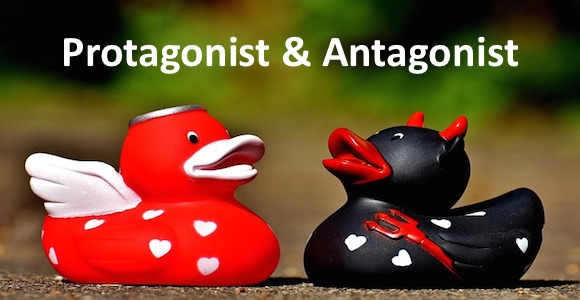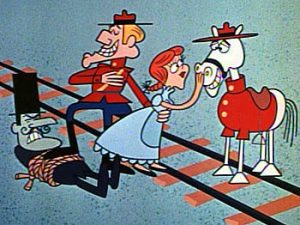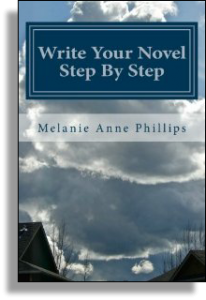
Protagonist drives the plot forward.
Antagonist tries to stop him.
The Protagonist is the Prime Mover of the effort to achieve the Story’s Goal. The Antagonist is the Chief Obstacle to that effort. In a sense, Protagonist is the irresistible force and Antagonist is the immovable object.
Often, a Protagonist is cast as the hero – trying to accomplish something for good purposes through unflinching dedication to the task. Similarly, the Antagonist is frequently cast as the villain – trying to prevent the Protagonist from achieving that task for evil purposes.
But good and evil are not part of what a Protagonist or Antagonist is. They are just qualities our culture often associates with the achiever and the stopper.
For example, consider where good and evil reside in a typical James Bond movie. Usually, it is the bad guy who hatches a plan and then sets off to realize it. And it is Bond who must try to stop the bad guy and set things right.
In this example, the villain is actually the Protagonist trying to achieve the goal (albeit an evil one) whereas Bond is the Antagonist trying to prevent a disaster.
So if, for a moment, we remove the preconception of a Protagonist being good and an Antagonist being bad, we might ask ourselves, where exactly do these two characters come from and how do they work dramatically in story structure?
In our own minds, we survey our environment and consider whether or not we could improve things by taking action to change them. The struggle between the Protagonist and Antagonist represents this inner argument: is it better to leave things the way they are or to try and rearrange them?
The Protagonist represents our Initiative, the motivation to change the status quo. The Antagonist embodies our Reticence to change the status quo. These are perhaps our two most obvious human traits – the drive to alter our environment and the drive to keep things the way they are. That is likely why the Archetypes that represent them are usually the two most visible in a story.
Functionally, the character you choose as your Protagonist will exhibit unswerving commitment to effecting change. No matter what the obstacles, no matter what the price, the Protagonist will charge forward and try to convince everyone else to follow.
Without a Protagonist, your story would have no directed thrust. It would likely meander through a series of events without any sense of compelling inevitability. When the climax arrives, it would likely be weak, not seen as the culmination and moment of truth so much as simply the end.
This is not to say that the Protagonist won’t be misled or even temporarily convinced to stop trying, but like a smoldering fire the Protagonist is a self-starter. Eventually, he or she will ignite again and once more resume the drive toward the goal.
Still, do not feel obligated to fashion a Protagonist whose storytelling qualities make it the most forceful character. The Protagonist does not have to be the most powerful personality. Rather, it will simply be the character who keeps pressing forward, even if in a gentle manner until all the obstacles to success are either overcome or slowly eroded.
When creating your own stories, sometimes you will know exactly what your goal is right off the bat. In such cases, the choice of Protagonist is usually an easy one. You simply pick the character whose storytelling interests and nature are best suited to the objective.
Other times, you may begin with only a setting and a cast of interesting characters but have no idea what the goal of the story will be. By trying out the role of Protagonist on each of your characters, you can determine what kind of a goal the nature of each character might suggest.
By working out an appropriate goal for each character as if it were the Protagonist, you’ll have a choice of goals. And once you have chosen one as the story goal, each of your other characters now has a clear motivation of their own – a tangible end-game they are hoping to achieve for themselves as a result of their part in the effort to achieve the overall story goal.
What, now, of the Antagonist? We have all heard the idioms, Let sleeping dogs lie, Leave well enough alone, and If it works – don’t fix it. All of these express that very same human quality embodied by the Antagonist: Reticence.
To be clear, Reticence does not mean that the Antagonist is afraid of change. While that may be true, it may instead be that the Antagonist is simply comfortable with the way things are or may even be ecstatic about them. Or, he or she may not care about the way things are but hate the way they would become if the goal were achieved.
Functionally, the character you choose as your Antagonist will try anything and everything to prevent the goal from being achieved. No matter what the cost, any price would not seem as bad to this character as the conditions he or she would endure if the goal comes to be. The Antagonist will never cease in its efforts and will marshal every resource (both human and material) to see that the Protagonist fails in his efforts.
Without an Antagonist, your story would have no concerted force directed against the Protagonist. Obstacles would seem arbitrary and inconsequential. When the climax arrives, it would likely feel insignificant, full of sound and fury, signifying nothing.
In choosing one of your characters as the Antagonist, don’t be trapped into only selecting a mean-spirited one. As described earlier, it may well be that the Protagonist is the Bad Guy and the Antagonist is the Good Guy. Or, both may be Good or both Bad.
The important thing is that the Antagonist must be in a position in the plot to place obstacles in the path of the Protagonist. Since the drive of the Protagonist is measured by the size of the obstacles he or she must overcome, it is usually a good idea to pick the character who can bring to bear the greatest obstacles.
In summary, while you may find it easier to write by thinking in terms of good guys and bad guys or heroes and villains, be sure to step back every once in a while and consider the underlying dramatic functions represented by the Protagonist and Antagonist regardless of noble or ill intent.
Also from Melanie Anne Phillips…


 The protagonist and antagonist may not be who you think they are. For one thing, a protagonist is not necessarily the hero of a story. Structurally speaking, the protagonist is the one who shakes up the status quo – that’s the “pro” part, while the antagonist is the one who tries to stop that effort or put it back the way it was.
The protagonist and antagonist may not be who you think they are. For one thing, a protagonist is not necessarily the hero of a story. Structurally speaking, the protagonist is the one who shakes up the status quo – that’s the “pro” part, while the antagonist is the one who tries to stop that effort or put it back the way it was.
